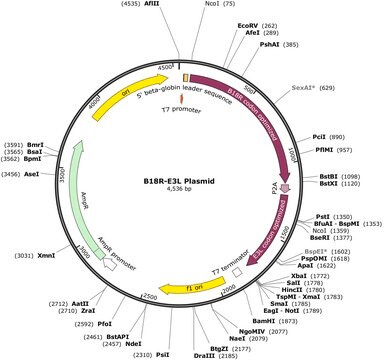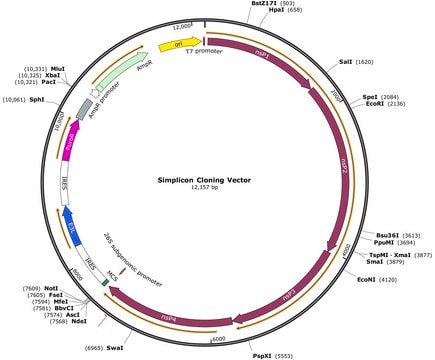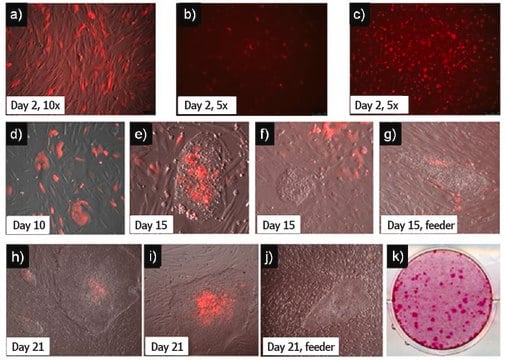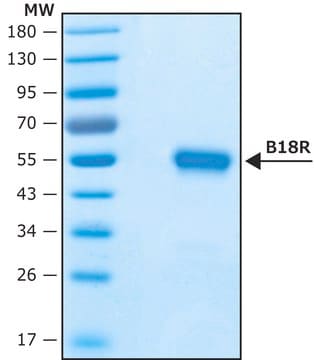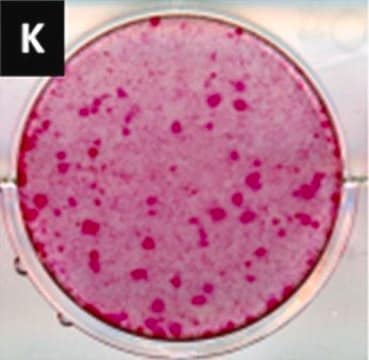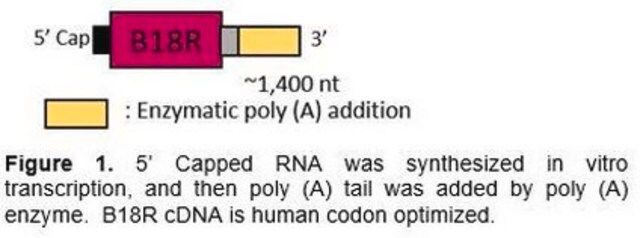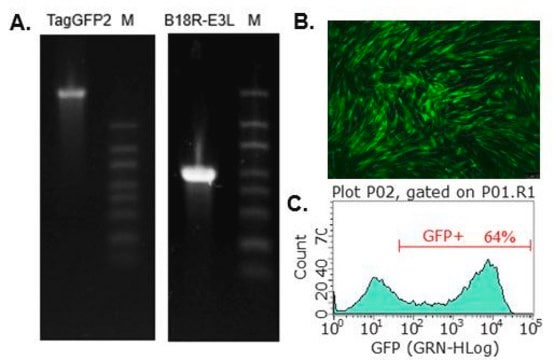SCR722
B18R-E3L RNA (human codon optimized for B18R and E3L)
To strongly suppress more interferon responses than single B18R to enable more expression of a Simplicon® RNA or regular mRNA(s).
Sign Into View Organizational & Contract Pricing
All Photos(2)
About This Item
UNSPSC Code:
12352207
eCl@ss:
32161000
NACRES:
NA.51
Recommended Products
technique(s)
nucleic acid detection: suitable (RNA)
shipped in
ambient
General description
Simplicon<TMSYMBOL></TMSYMBOL> is a novel system to effect immediate high sustained protein expression of multiple genes into transfected cells without the risk of genome integration. The technology employs a single, synthetic, polycistronic, self-replicating RNA based on the Venezuelan equine encephalitis (VEE) genome1,2,3. The Simplicon<TMSYMBOL></TMSYMBOL> RNA contains only genes encoding the VEE RNA replication machinery while the structural proteins that are required to make an infectious particle have been removed and replaced with the transgenes of interest.
Introduction and replication of the Simplicon<TMSYMBOL></TMSYMBOL> RNA is expected to elicit a strong interferon response in transfected cells. To suppress the IFN responses, a Vaccinia virus protein4, B18R, is used for the original Simplicon<TMSYMBOL></TMSYMBOL> technology. Recently, we found that another Vaccinia virus protein4, E3L, also suppresses the IFN responses in Simplicon<TMSYMBOL></TMSYMBOL> RNA expression. B18R neutralizes type I interferons by direct binding, while E3L inhibits the cytoplasmic signaling pathways of IFN responses. Therefore, B18R and E3L are both employed in the Simplicon<TMSYMBOL></TMSYMBOL> Expression System and work collaboratively to suppress IFN responses. As a result, there is increased cell viability during RNA transfection and increased expression of the transgenes. The Simplicon<TMSYMBOL></TMSYMBOL> Expression System works in human cells and is not expected to work in mouse cells. This is because the B18R does not effectively neutralize mouse interferon (IFN)-β.
The B18R-E3L RNA (human codon optimized for B18R and E3L) is a synthetic polycistronic mRNA that is co-transfected with the Simplicon<TMSYMBOL></TMSYMBOL> RNA to suppress the IFN responses. B18R-E3L RNA can also be used to prepare B18R conditioned medium by transfection into HFFs (Cat. No. SCC058). B18R-E3L RNA is also available for co-transfection of any mRNAs to suppress the IFN responses and enable repeated transfection of mRNAs. Please refer to the User Guide for Simplicon<TMSYMBOL></TMSYMBOL> Expression System located on our website.
Introduction and replication of the Simplicon<TMSYMBOL></TMSYMBOL> RNA is expected to elicit a strong interferon response in transfected cells. To suppress the IFN responses, a Vaccinia virus protein4, B18R, is used for the original Simplicon<TMSYMBOL></TMSYMBOL> technology. Recently, we found that another Vaccinia virus protein4, E3L, also suppresses the IFN responses in Simplicon<TMSYMBOL></TMSYMBOL> RNA expression. B18R neutralizes type I interferons by direct binding, while E3L inhibits the cytoplasmic signaling pathways of IFN responses. Therefore, B18R and E3L are both employed in the Simplicon<TMSYMBOL></TMSYMBOL> Expression System and work collaboratively to suppress IFN responses. As a result, there is increased cell viability during RNA transfection and increased expression of the transgenes. The Simplicon<TMSYMBOL></TMSYMBOL> Expression System works in human cells and is not expected to work in mouse cells. This is because the B18R does not effectively neutralize mouse interferon (IFN)-β.
The B18R-E3L RNA (human codon optimized for B18R and E3L) is a synthetic polycistronic mRNA that is co-transfected with the Simplicon<TMSYMBOL></TMSYMBOL> RNA to suppress the IFN responses. B18R-E3L RNA can also be used to prepare B18R conditioned medium by transfection into HFFs (Cat. No. SCC058). B18R-E3L RNA is also available for co-transfection of any mRNAs to suppress the IFN responses and enable repeated transfection of mRNAs. Please refer to the User Guide for Simplicon<TMSYMBOL></TMSYMBOL> Expression System located on our website.
Application
B18R-E3L RNA (human codon optimized for B18R and E3L) is provided as a polycistronic mRNA with both the B18R and E3L genes to more strongly suppress the interferon (IFN) responses that degrades Simplicon RNA(s) or regular mRNA(s). B18R RNA (E3L) works at single co-transfection with Simplicon RNA or repeated co-transfection with regular mRNA(s). B18R RNA (E3L) can also be used for production of B18R-CM (B18R-conditioned medium).
•Co-transfection with Simplicon RNA
•Co-transfection with mRNA for repeated transfection
•Production of B18R conditioned medium
•Co-transfection with Simplicon RNA
•Co-transfection with mRNA for repeated transfection
•Production of B18R conditioned medium
Components
B18R-E3L RNA (human codon optimized for B18R and E3L), human codon optimized: (Cat. # CS224503), One (1) vial containing 10 µL of RNA (1 µg/µL). Store at -80 °C.
Quality
•Discrete RNA band on RNA gel of appropriate size.
•40-60% GFP-positive human foreskin fibroblasts (HFFs) with FACS analysis.
•40-60% GFP-positive human foreskin fibroblasts (HFFs) with FACS analysis.
Storage and Stability
B18R-E3L RNA (human codon optimized for B18R and E3L): (Cat. # CS224503) One (1) vial containing 10 µL of RNA (1 µg/µL). Store at -80 °C.
Legal Information
SIMPLICON is a registered trademark of Merck KGaA, Darmstadt, Germany
Disclaimer
Unless otherwise stated in our catalog or other company documentation accompanying the product(s), our products are intended for research use only and are not to be used for any other purpose, which includes but is not limited to, unauthorized commercial uses, in vitro diagnostic uses, ex vivo or in vivo therapeutic uses or any type of consumption or application to humans or animals.
Storage Class
12 - Non Combustible Liquids
Certificates of Analysis (COA)
Search for Certificates of Analysis (COA) by entering the products Lot/Batch Number. Lot and Batch Numbers can be found on a product’s label following the words ‘Lot’ or ‘Batch’.
Already Own This Product?
Find documentation for the products that you have recently purchased in the Document Library.
Our team of scientists has experience in all areas of research including Life Science, Material Science, Chemical Synthesis, Chromatography, Analytical and many others.
Contact Technical Service